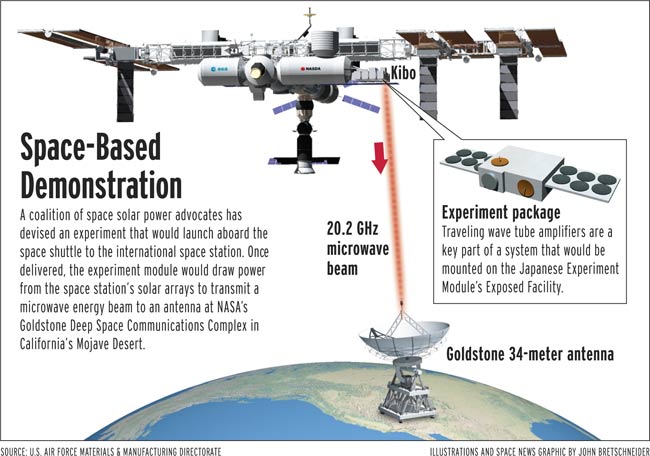Under New Plan, Satellites to Beam Solar Power Down From Space

In a step toward solving the global energy crisis, a new plan aims to harvest the sun's energy from space with satellites then beam it down to Earth.
The initiative, announced Nov. 4, is spearheaded by former president of India A.P.J. Kalam and the National Space Society, a nonprofit dedicated to making humanity a spacefaring civilization.
Space-based solar power has the potential to turn Earth into a "clean planet, a prosperous planet, and a happy planet," Kalam said during a Thursday press conference announcing the Kalam-NSS Energy Initiative.
The initiative's plan is to launch a satellite containing a large array of solar panels that would collect energy from the sun, then convert this energy into a microwave beam that could be directed back down to Earth. A special receiving antenna on the ground — called a rectenna — would then turn the microwave energy back into electricity, which would be fed into the power grid.
Earth's energy crisis
Global energy needs are expected to grow by 87 percent by the year 2035. Traditional renewable energy sources will only be able to meet part of that demand, proponents of the space plan said.
Space-based solar power could be directed to multiple locations in the world, and wouldn't suffer from outages during nighttime or bad weather, as solar panels on the ground do, said Mark Hopkins, chair of the National Space Society's executive committee.
Get the Space.com Newsletter
Breaking space news, the latest updates on rocket launches, skywatching events and more!
The technology offers the potential to deliver a tremendous amount of energy without harming the environment, he said.
"It produces virtually no carbon dioxide, therefore it's a very clean, renewable energy source," Hopkins said.
However, the full technology to achieve such a vision is not yet developed.
"One of the critical things to keep in mind regarding this capability is that it has enormous promise to deliver power globally — power that would be very green — but also that we're not quite ready to do it yet," said John Mankins, president of the Space Power Association. "It has some remaining technical challenges."
Leaders of the plan agreed the idea will take some work, but added that's why it's important to get the project started now.
"I personally believe it is a project of about 15 years," Kalam said, adding that it would take the support of more countries than the United States and India to make space solar power a reality. He proposed approaching the governments of G8 and G13 countries to eventually join the initiative.
International solar initiative
NASA does not currently have an official space solar power program, though it has funded research into the field in the past. Work to send a solar energy-beaming experiment to the International Space Station was canceled in 2008.
The U.S. military has also experimented with solar energy beaming, as it may present a way to deliver power to remote areas of the globe.
Ultimately, such a partnership between the U.S. and India could have ramifications not just for the energy crisis, but for international politics, the initiative's leaders said.
"India is rapidly rising and this is in the interest of both nations," Hopkins said. "Neither of our nations wishes to contain China — however, a prosperous India increases the chances the rise of China will be peaceful."
Under the Kalam-NSS plan, the United States would contribute technology, while India could take care of much of the low-cost manufacturing.
"The potential of combining those two could generate a large amount of jobs in both countries," Hopkins said.
India could also potentially launch the power-gathering satellite aboard one of the nation's rockets.
"It is known that such a proposal can become reality only if the cost of launching satellites into outer space is made economical," said T.K. Alex, director of the Indian Space Research Organization Satellite Centre, which launches spacecraft for both communications and science.
The ISRO has ramped up its space activities in recent years, notably with the launch of India's first moon satellite, Chandrayaan-1, in 2008, with a second mission under development.
Join our Space Forums to keep talking space on the latest missions, night sky and more! And if you have a news tip, correction or comment, let us know at: community@space.com.

Clara Moskowitz is a science and space writer who joined the Space.com team in 2008 and served as Assistant Managing Editor from 2011 to 2013. Clara has a bachelor's degree in astronomy and physics from Wesleyan University, and a graduate certificate in science writing from the University of California, Santa Cruz. She covers everything from astronomy to human spaceflight and once aced a NASTAR suborbital spaceflight training program for space missions. Clara is currently Associate Editor of Scientific American. To see her latest project is, follow Clara on Twitter.









